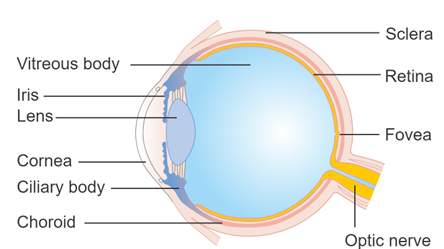Eye cancer
Eye cancer is relatively rare. It affects about 60* people in Ireland each year.
Signs and symptoms
Learn about the signs and symptoms of eye cancer. You are more likely to survive cancer if you find it at an earlier stage.
Treatments
There are a number of different treatments available for eye cancer. Your medical team will explain the best treatment options for you.
What is eye cancer?
Eye cancer describes a cancer that develops in cells in one of the parts of the eye. The type of cancer that develops depends on the type of cell it begins in. Occular melanoma is the most common type of eye cancer.
Eye cancer is a rare cancer: around 60 people are diagnosed with eye cancer in Ireland every year.* They are also known as ocular cancers.
What are the types of eye cancer?
- Cancers in the inside the eyeball are known as intraocular.
- Cancers outside the eyeball are extraocular.
Melanoma is the most common intraocular cancer in adults, followed by intraocular lymphoma.
Retinoblastoma cancer in the retina is the most common intraocular cancer in children, followed by medulloepithelioma.
Most melanomas start in the skin but can also develop in other parts of your body, including the eye.
Intraocular melanoma begins in the middle layer of the eye, the choroid. This layer has cells that make the pigment melanin, which become malignant (cancerous).
A small number of melanomas occur in the iris, the coloured part of your eye. If the melanoma spreads to the optic nerve or nearby tissue of the eye socket, it is called extraocular.
It may also spread to the liver, lung or bone, or to areas under your skin.
Lymphoma of the eye is very rare. Lymphoma usually begins in the lymph nodes that are part of your immune system.
There are two different types of lymphoma and intraocular lymphomas are always the non-Hodgkin type.
Squamous cell cancer of the eye is very rare. Most squamous cell cancers grow in the skin. If they start in the eye, it is usually in the conjunctiva.
These are cancers that have spread to the eye from another part of your body. For example, breast cancer and lung cancer.
These are not eye cancer but they are more common than primary intraocular cancers.
What is the eye?
The eye is the organ of sight. It sits in a little hollow area in your skull called the eye socket. The eyelids protect the front of your eyes and keep them moist and clean.

Your eye has three layers:
The outer later - the white of your eye along with the clear part at the front of your eye called the cornea. This layer protects your eye.
The middle layer. The front uvea includes the iris and ciliary body, while the back uvea is the choroid, which is rich in blood vessels and pigmented cells. The iris is the coloured part of your eye with the pupil in the centre, which changes size to let more or less light into your eye. The ciliary body is a muscle behind the iris that changes the size of your pupil and the shape of your lens to help your eye focus.
The inner layer. This has nerve cells that are sensitive to light and sends messages to your brain along the optic nerve.
The conjunctiva is a thin membrane that covers the surface of your inner eyelid and the white part of your eyeball.
What increases my risk of eye cancer?
The risk factors for eye cancer include:
If you have blue, green or grey eyes, you are more likely to develop melanoma of the eye than if you have brown eyes.
If you are fair skinned, you are more likely to get eye cancer than if you have dark skin.
Generally, the risk of developing cancer increases as you get older.
If you have moles, you have a higher risk of skin and eye melanoma.
If you expose yourself to too much sun, it increases your risk of skin melanoma but also eye melanoma and squamous cell cancer of the eye.
If you work as a welder, you may be at increased risk of melanoma of the eye. If you use sunbeds, your risk is also increased.
If you take medication to avoid organ rejection after a transplant, you might be at increased risk of lymphoma of the eye or squamous cell cancer of the eye. Your risk is also increased if you have certain viruses like AIDS or human papilloma virus (HPV) or autoimmune diseases like rheumatoid arthritis.
Having a risk factor doesn’t mean you will definitely get cancer. Sometimes people with no risk factors get the disease. If you’re worried, talk to your GP or talk to one of our cancer nurses. Call our Support Line on 1800 200 700 or visit a Daffodil Centre.
Reducing your risk of eye cancer
The most important things you can do to reduce your risk of eye cancer are to:
- Protect your eyes from UV radiation by using proper eye protection
- Go to an optician regularly
Talk to a Cancer Nurse

Support Line
Our Daffodil Centres

*The Irish Cancer Society uses the most up-to-date cancer statistics from the National Cancer Registry Ireland, available on www.ncri.ie
